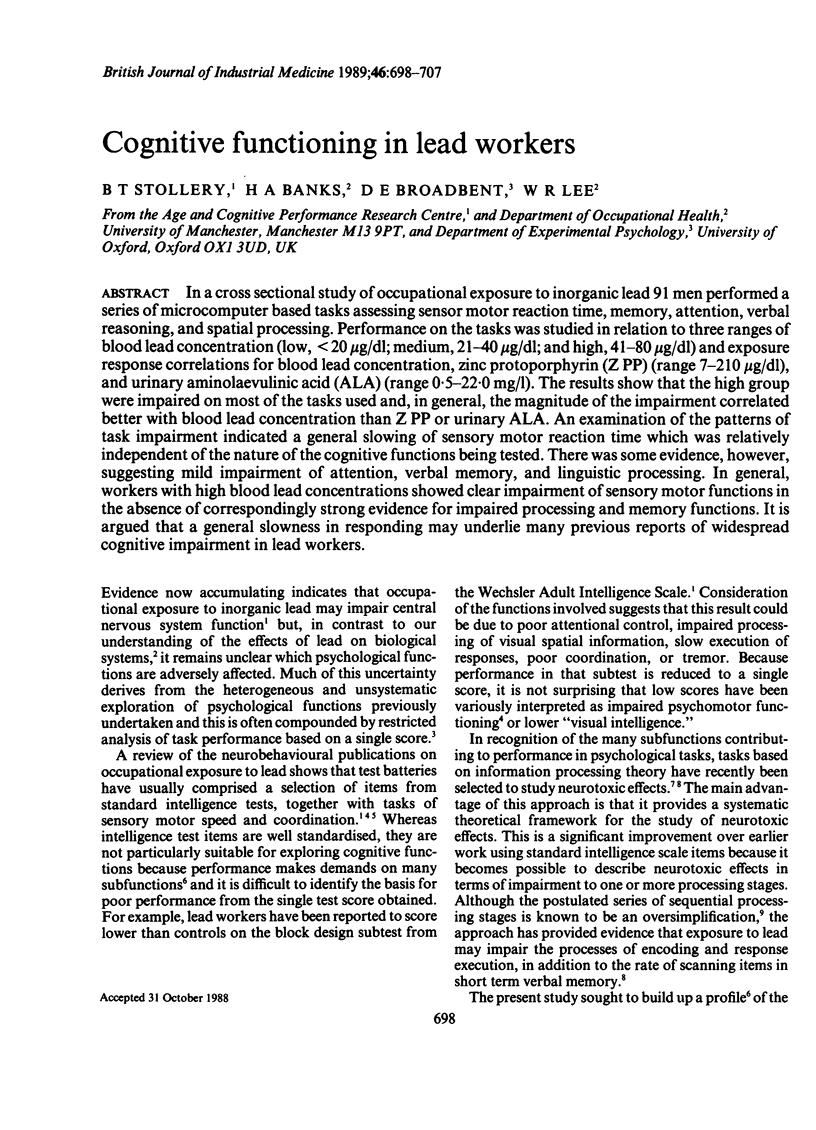Abstract
In a cross sectional study of occupational exposure to inorganic lead 91 men performed a series of microcomputer based tasks assessing sensor motor reaction time, memory, attention, verbal reasoning, and spatial processing. Performance on the tasks was studied in relation to three ranges of blood lead concentration (low, less than 20 micrograms/dl; medium, 21-40 micrograms/dl; and high, 41-80 micrograms/dl) and exposure response correlations for blood lead concentration, zinc protoporphyrin (ZPP) (range 7-210 micrograms/dl), and urinary aminolaevulinic acid (ALA) (range 0.5-22.0 mg/l). The results show that the high group were impaired on most of the tasks used and, in general, the magnitude of the impairment correlated better with blood lead concentration than ZPP or urinary ALA. An examination of the patterns of task impairment indicated a general slowing of sensory motor reaction time which was relatively independent of the nature of the cognitive functions being tested. There was some evidence, however, suggesting mild impairment of attention, verbal memory, and linguistic processing. In general, workers with high blood lead concentrations showed clear impairment of sensory motor functions in the absence of correspondingly strong evidence for impaired processing and memory functions. It is argued that a general slowness in responding may underlie many previous reports of widespread cognitive impairment in lead workers.
Full text
PDF









Selected References
These references are in PubMed. This may not be the complete list of references from this article.
- Baker E. L., Feldman R. G., White R. A., Harley J. P., Niles C. A., Dinse G. E., Berkey C. S. Occupational lead neurotoxicity: a behavioural and electrophysiological evaluation. Study design and year one results. Br J Ind Med. 1984 Aug;41(3):352–361. doi: 10.1136/oem.41.3.352. [DOI] [PMC free article] [PubMed] [Google Scholar]
- Brosan L., Broadbent D., Nutt D., Broadbent M. Performance effects of diazepam during and after prolonged administration. Psychol Med. 1986 Aug;16(3):561–571. doi: 10.1017/s0033291700010321. [DOI] [PubMed] [Google Scholar]
- Feldman R. G., Ricks N. L., Baker E. L. Neuropsychological effects of industrial toxins: a review. Am J Ind Med. 1980;1(2):211–227. doi: 10.1002/ajim.4700010212. [DOI] [PubMed] [Google Scholar]
- Grandjean P., Arnvig E., Beckmann J. Psychological dysfunctions in lead-exposed workers. Relation to biological parameters of exposure. Scand J Work Environ Health. 1978 Dec;4(4):295–303. doi: 10.5271/sjweh.2696. [DOI] [PubMed] [Google Scholar]
- Haenninen H., Hernberg S., Mantere P., Vesanto R., Jalkanen M. Psychological performance of subjects with low exposure to lead. J Occup Med. 1978 Oct;20(10):683–689. [PubMed] [Google Scholar]
- Lee W. R. What happens in lead poisoning? J R Coll Physicians Lond. 1981 Jan;15(1):48–54. [PMC free article] [PubMed] [Google Scholar]
- Levin E. D., Bowman R. E., Wegert S., Vuchetich J. Psychopharmacological investigations of a lead-induced long-term cognitive deficit in monkeys. Psychopharmacology (Berl) 1987;91(3):334–341. doi: 10.1007/BF00518187. [DOI] [PubMed] [Google Scholar]
- Mackay C., Cox T., Burrows G., Lazzerini T. An inventory for the measurement of self-reported stress and arousal. Br J Soc Clin Psychol. 1978 Sep;17(3):283–284. doi: 10.1111/j.2044-8260.1978.tb00280.x. [DOI] [PubMed] [Google Scholar]
- Robbins T. W. Cortical noradrenaline, attention and arousal. Psychol Med. 1984 Feb;14(1):13–21. doi: 10.1017/s0033291700003032. [DOI] [PubMed] [Google Scholar]
- Shellenberger M. K. Effects of early lead exposure on neurotransmitter systems in the brain. A review with commentary. Neurotoxicology. 1984 Fall;5(3):177–212. [PubMed] [Google Scholar]
- Silbergeld E. K., Hruska R. E., Miller L. P., Eng N. Effects of lead in vivo and in vitro on GABAergic neurochemistry. J Neurochem. 1980 Jun;34(6):1712–1718. doi: 10.1111/j.1471-4159.1980.tb11265.x. [DOI] [PubMed] [Google Scholar]
- Silbergeld E. K., Lamon J. M. Role of altered heme synthesis in lead neurotoxicity. J Occup Med. 1980 Oct;22(10):680–684. doi: 10.1097/00043764-198010000-00016. [DOI] [PubMed] [Google Scholar]
- Stollery B. T. Effects of 50 Hz electric currents on mood and verbal reasoning skills. Br J Ind Med. 1986 May;43(5):339–349. doi: 10.1136/oem.43.5.339. [DOI] [PMC free article] [PubMed] [Google Scholar]
- Stollery B. T. Effects of 50 Hz electric currents on vigilance and concentration. Br J Ind Med. 1987 Feb;44(2):111–118. doi: 10.1136/oem.44.2.111. [DOI] [PMC free article] [PubMed] [Google Scholar]
- Valciukas J. A., Lilis R., Eisinger J., Blumberg W. E., Fischbein A., Selikoff I. J. Behavioral indicators of lead neurotoxicity: results of a clinical field survey. Int Arch Occup Environ Health. 1978 Jul 14;41(4):217–236. doi: 10.1007/BF00378753. [DOI] [PubMed] [Google Scholar]
- Williamson A. M., Teo R. K. Neurobehavioural effects of occupational exposure to lead. Br J Ind Med. 1986 Jun;43(6):374–380. doi: 10.1136/oem.43.6.374. [DOI] [PMC free article] [PubMed] [Google Scholar]
- Williamson A. M., Teo R. K., Sanderson J. Occupational mercury exposure and its consequences for behaviour. Int Arch Occup Environ Health. 1982;50(3):273–286. doi: 10.1007/BF00378089. [DOI] [PubMed] [Google Scholar]


